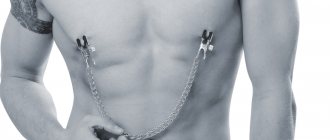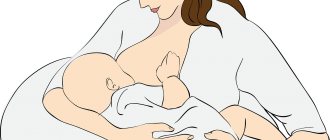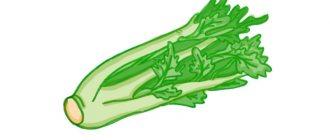• Why is it important to properly establish breastfeeding?
If your baby screams while feeding, it may well be that breastfeeding is not going well. This may mean that it is uncomfortable for the baby to latch onto the breast as expected during feeding, and it is difficult for him to “get” milk. Often, if the nipple is not grasped correctly, a lot of air gets into the baby’s stomach along with the milk, which has a bad effect on the baby’s digestion and can cause pain, colic and the formation of gas in the stomach.
Such problems can be solved by simply changing the position during feeding; for example, it is enough to feed the baby while holding him in an upright position (let him eat standing or sitting). In addition, sucking at the breast in a comfortable position calms and relaxes the baby, which helps release gases from the intestines, and helps to poop in case of intestinal problems.
The most common cause of cracked nipples is improper attachment to the breast. And if you have nipples of an unusual shape, then the baby will be able to suck properly only in certain positions, and with your help. Therefore, it is important for mom to figure out in advance how to hold the baby, how to give her breast to the baby, so that it is easier for him to take it. After all, the baby actually sucks not the nipple at all, but the areola around it! Therefore, if you can master the correct attachment, the unusual shape of the nipples will not be an obstacle to feeding.
With breast lactostasis (lumps), it is especially important to choose positions for feeding a newborn. During sucking, different lobes of the breast are emptied unevenly. The baby sucks milk best from the lobes located during sucking just in front of the chin and in front of the baby's nose. Therefore, if your breasts hurt after childbirth, they are hard, choose a position so that the baby’s nose or chin is directed towards the formed lump.
In practice, mothers most often use only three positions or basic positions for breastfeeding a newborn in a variety of options. Choose the feeding position that will be most comfortable for both of you. And to make your choice easier, we offer you breastfeeding positions with photos.
Top
Indicators of correct latch on the breast in a newborn
If the baby has taken the breast correctly once, this does not mean that there is no need to further control this process. Every time you feed, it is important to look for signs of a good latch. Let's call them:
- The baby's nose is open and breathes freely.
- The chin is pressed to the chest.
- The newborn grasps not only the nipple, but also most of the areola.
- Mommy does not experience pain.
- The sucking process begins with short movements, and then the child makes longer and slower movements with his mouth.
- Sounds characteristic of swallowing are heard.
Each woman has a unique nipple shape. If they are flat and retracted, some difficulties may arise.
You might be interested in: How to wean your baby
Sometimes the doctor may recommend special silicone pads that make the sucking process easier for the baby.
Expert opinion
Ksenia Dunaeva
User experience expert and comment moderator. Higher medical education and more than 5 years of actual practice.
Ask Ksenia
Pain during breastfeeding, cracked nipples, poor weight gain, and insufficient urination are all signs of an improper latch. If you cannot master the correct breastfeeding tactics on your own, it is important to contact a specialist who will help you organize this process.
• Postures for breastfeeding, photo instructions:
| |
Photo No. 1. Classic “Lullaby” | •The mother holds the baby in front of the chest, with one hand clasping it, and the other falling on the baby's chest. |
Photo No. 2. “Cross cradle” | •Other women prefer the same position, but with slight modifications. The mother clasps the baby with the hand opposite the breast that the baby is sucking. For example, if a baby is suckling on the left breast, then the mother holds him with her right hand and feeds the breast with her left. This option is called a "cross cradle". It is especially relevant for newborns, because the mother holds the baby’s head with her palm. |
Postures for breastfeeding, photo No. 3: | •Make sure that the baby grasps the mother's breast correctly: the nipple should be in the upper part of the baby's mouth, closer to his nose. |
| |
Photo No. 4: | •Lie on your side with several pillows under your head for comfort. |
Photo No. 5: | •Place your baby on the pillow, holding him gently with your hand. |
Photo No. 6: | •Breastfeeding positions with a pillow are always more comfortable. |
Photo No. 7: | •Place your baby on the bed with his feet up, towards your head. |
Positions for feeding with the upper breast, photo No. 8: | •If for some reason it is more convenient for the mother to feed the baby lying on one side, then you can use positions that allow you to feed not only the lower breast, facing the baby, but also the upper one. In addition, this position can help cope with stagnation of milk in the breast, which often forms in the inner lower part of the mother’s breast. |
Poses for breastfeeding from under the arm, from under the arm, photo No. 9: | •The baby lies on the side of the mother, his tummy is at the mother’s side, his legs go back, and his head is at the chest. |
Photo No. 10: | •Underarm feeding is also more convenient after a caesarean section. |
Feeding position when the baby is on top, photo No. 11: | •This position is suitable for those mothers whose milk flows heavily. At the same time, babies often begin to choke, not having time to swallow breast milk. If you sit in a reclining position and place the baby on top of your chest, the flow will not be so intense. The baby will be able to suckle more calmly, and the mother will have a rest. |
Breastfeeding in the baby's sitting position, photo No. 12: | •This situation is certainly relevant for infants who are already grown up, older than six months. As a rule, they really like to eat, sitting astride their mother’s lap, while looking at mommy and “communicating” with her, without letting go of their breasts. |
Top
• Important rules for breastfeeding
We recommend that you learn to feed your baby in different positions as early as possible.
First of all, it is comfortable. Changing positions will give you the opportunity to unload some of the most tired muscles while others work. After all, a mother and her baby have to endure serious physical exertion.
In addition, breastfeeding newborns in different positions ensures better emptying of different segments of the breast, which can protect you from milk stagnation, lactostasis and other problems.
Proper attachment is the key to successful breastfeeding. You need to pay attention to several important signs that your baby is latching onto your breast correctly, namely:
- 1. During sucking, almost the entire isola dark circle appears in the baby’s mouth, and not just the nipple;
- 2. The baby’s lower lip is turned outward, you can even see the baby’s tongue from the side;
- 3. The baby’s chin and nose lightly touch the mother’s chest, and are not recessed into it;
- 4. During sucking you do not experience pain, and if there is discomfort in the first seconds, then it weakens during the feeding process and does not intensify.
To properly remove the breast from your baby's mouth after feeding, insert your little finger into the corner of the mouth and then remove it. This is necessary in order to break the vacuum that occurs during sucking. Then there will be no need to pull the breast from the baby's mouth, and the nipple will not be damaged.
There are certain breastfeeding rules that should be followed regardless of the position for feeding a newborn, namely:
- In any feeding position, it is important that the baby’s body is in the same plane, the whole - head, shoulders, legs and, of course, tummy. For example, in a lying position, the baby should lie on the side, and not on the back, with the head turned to one side towards the mother’s chest - this makes swallowing difficult and provokes muscle tension.
- Very small children should be clasped diagonally with your hand, from head to toe, with a delicate but confident grip, fixing the baby’s head. The breast should be served, supporting it like a bowl, from below with four fingers and from above with the thumb.
- Always pull your baby to your chest, taking a comfortable position, and not stretching your chest towards him or bending too much.
- You need to place your breasts deeper into your mouth, along with the areola (the entire nipple circle). In the case of an impressive size of the areola, make sure that the child grasps it from below more than from above (relative to the child’s mouth).
- The baby's lips should be slightly turned outward, the tongue should be located on the lower gum. It is very important that there are no clicking or smacking sounds accompanying sucking. If they are present (sounds), ask the doctor to check the frenulum of the baby’s tongue. The short frenulum should be trimmed so that the baby can suckle fully, without injuring the mother.
- Where you feed your baby most often, it is recommended to have several pillows of different sizes so that you can always be seated correctly and comfortably.
Mommy may face some difficulties at first. But you shouldn't give up. If you can’t cope on your own, contact consultants for help to establish breastfeeding. Ask to teach you how to attach your baby correctly while still in the maternity hospital, gain experience from other, more experienced mothers.
Top
Learning how to properly attach a newborn to the breast
So, as you can already understand, putting a baby to the breast is not such a simple matter.
You might be interested in: Which formulas are best for newborns for mixed feeding
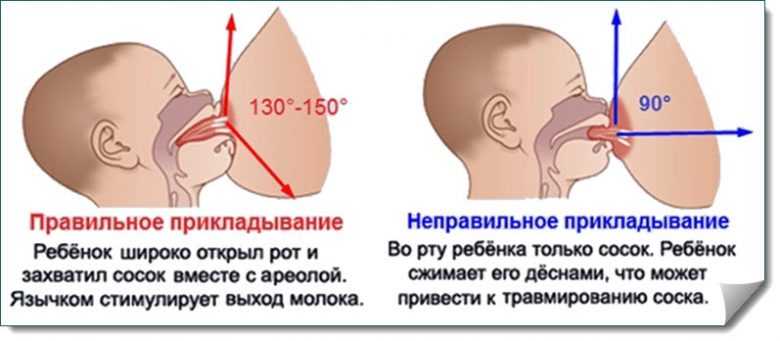
Let's figure out how to do this correctly so that the newborn gets enough milk, and the mother does not have problems with cracks and pain.
Baby's position during feeding
Whatever feeding position you choose, the baby must be in the correct position. Its head and back should be level. If the baby is in a curled position, this is not correct. When positioned correctly, the newborn's chin should point upward. It should not be allowed to press against the chest. It is also important that mommy is comfortable. To do this, you can place a special feeding pillow under your back. It can be purchased online or in specialized stores.
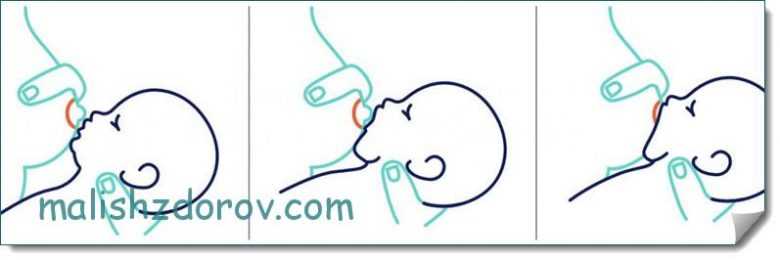
You may be interested in learning about the best position to feed your newborn. Only useful information for you.
Guiding the child correctly
After you bring the baby to your breast and he opens his mouth, press him to you, while pointing your nipple towards his palate. Please note that when performing this manipulation, the baby's chin should touch the areola first. The baby should capture not only the nipple, but also almost the entire areola. If the size of the halos is small, the newborn may capture it completely. Don't worry, this is right. Later, the baby will understand how to properly latch onto the breast so that milk flows easily into his mouth.
Holding the baby straight
Each woman has her own breast size and shape. Try to find a position that allows your newborn to latch onto the nipple correctly, but you can also hold it as close to you as possible. Let us remind you that the baby’s chin should touch the chest, and its back and head should be positioned straight, without twisting. Also make sure that the mammary gland does not block the breathing of your son or daughter. The spout should be open and pointing upward.
You might be interested in: Newborn feeding positions
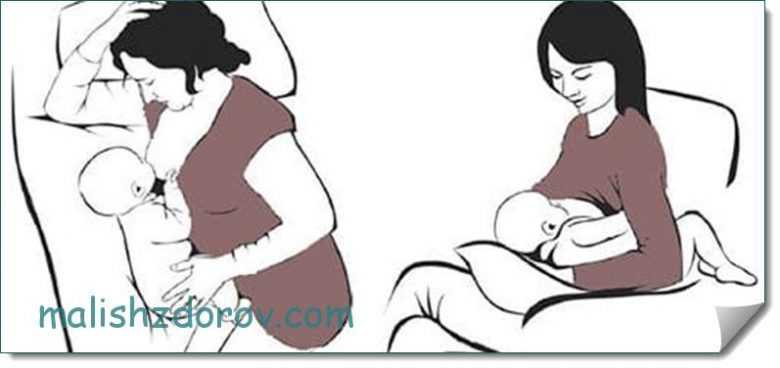
1246847579
If the baby is not attached correctly, the baby may have breathing problems. It is important to ensure that it does not rest its nose on your chest.
Listen to your newborn
Monitor your baby while feeding. Remember, the nipple should point towards the sky, the chin should rest on the chest, the nose should be open, and the back and head should be level. At first, the little one will instinctively perform short movements that help stimulate the flow of milk. As soon as the milk comes, the baby's movements will become longer and slower. This indicates that everything is going as it should.

Pay attention to how the baby's jaw moves and whether there are sounds of swallowing and sucking. Their presence indicates that the baby is receiving milk. In addition, it is important to pay attention to the amount of urination the newborn has and weight gain. Using these indicators, you can determine whether the toddler is receiving enough milk.
What to do if the grip is incorrect?
If the mother feels that the newborn has taken the breast incorrectly, pain and discomfort have appeared, she should remove the baby and try to attach it to the nipple again, but this time correctly. You may have to make none of these attempts. Don't despair. Sooner or later the little one will understand what is required of him.
• Postures for feeding a newborn with milk stagnation
If you do experience lactostasis (stagnation of milk in one of the lobes of the breast), you need to establish effective drainage of milk from the lobe where the stagnation has formed. This can be achieved by applying to the breast in such a way that the baby’s lower jaw falls precisely on this lobe with stagnation.
The strongest outflow of milk occurs precisely in the place where the lower jaw works, that is, the baby’s chin. For example, if congestion occurs in the upper part of the chest (imagine the chest in the form of an ordinary clock, the described case is about 12 o’clock), then lie on your side, with the side of the problem chest on the bed, and place the baby with your jack - so that the baby’s legs are in the direction of mom's head. If necessary, place a pillow under your baby's head or under his entire body.
In other cases, experiment with basic poses, adjusting them so that the child’s lower jaw (or at least the upper jaw, if that doesn’t work out - there is also a large outflow there, but less than at the bottom) is as close as possible to the place of stagnation.
Breastfeeding positions with a pillow will help you adapt any position to your needs. Place several pillows of different sizes under the baby, hold him horizontally or vertically, and then you can change the position of the baby's gums relative to your chest as you need.
Top
